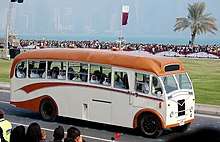Transport in Qatar
Public transport

In 2002, the Qatari government launched Mowasalat, a company 100% owned by the government, managed and operated by the state authorities to ensure the smooth provision of "integrated ground transport services" for the entire country with a growing population of more than 1,400,000 people. Previously, 3,000 privately owned orange taxis used to rule the streets of Qatar but the government took them off the roads as they saw them as a threat to the new Mowasalat taxis. There has been much controversy over this move, as it is now very hard to find a taxi in Doha.
Public buses now service over 35 routes covering most locations of Doha with minimal fares making public transport in Qatar a thrifty solution to the problems of rush hours and parking difficulties.
Presently, Mowasalat, under the brand-name 'Karwa', now operates more than 3,000 new and well-maintained taxi sedans including the recently acquired airport taxis with spacious cabins using the 2007 Ford Freestars, and more than 120 public buses, school buses and private-hire coaches. In 2009, the Mowasalat created a world record for the largest parade of buses numbering 300 in all.[1] In addition, its Doha Limousine Service has 100 standard (unbranded, no Karwa logo) limousines and 200 (Jaguar XJ) VIP units that are mostly placed at the Doha International Airport and at major hotels.
However, those who are with no own transportation still face difficulties to move around since the number of taxis are much less compared to the actual need of the increased population. All the line buses operate only through the assigned specific lines based to the Central Bus Stations at Al-Ghanem area of the old city.[2]
Railways
There are currently no major railways in Qatar.
In August 2008 Qatari Diar Real Estate Investment created a Joint-Venture with Deutsche Bahn International of Germany, Qatar Railway Development Company to plan a railway network in Qatar.[3] On 22 November 2009 Deutsche Bahn and Qatari signed a memorandum of Agreement to build high-speed railway lines and underground transport networks in Qatar and Bahrain.[4] This agreement has never been executed. The Qatar Railways Development Company (QRDC) was created in 2011, and, soon after this, it has been decided that Qatar Rail will be the sole owner and manager of Qatar's rail network and will be responsible for the design, construction, commissioning, operation and maintenance of the entire rail network and systems. However,
Qatar Rail will consist of:
- Doha Metro (Contract awarded for civil works, Rolling Stocks and Systems)
- Long Distance
- Light Rail Transit for Lusail (the other LRT systems in Doha, namely for Education City and Hamad International Airport are managed outside Qatar Rail.
The total length of the Qatar Rail network will consist of approximately:
- 750 km of track
- 100 stations for both passenger and freight[5]
In June 2013, Qatar Rail awarded four design and build contracts worth approximately $8.2 billion for phase one of the Doha metro. The project will include four rail lines and an underground section in the center of the capital Doha and will link stadiums for the 2022 World Cup soccer tournament. The contracts were for the Red Line North project, the Red Line South project, the Green Line project and another one to design and build the metro's major stations. The projects are expected to employ more than 20,000 workers at its peak, construction is scheduled to begin later this year for completion by 2019. Construction of the metro was originally planned to start in the first quarter of 2010.[6]
Standards
- Gauge: 1,435 mm (4 ft 8 1⁄2 in)
- Brakes: Air
- Couplings (freight): TBA
- Electrification: 25kV AC
Highways
- Total: 1,230 km
- Paved: 1,107 km
- Unpaved: 123 km (1996 est.)
Most of the main roads in this tiny country have been updated to multilane, double carriageway motorways, including the following:
- Al Shamal Highway: Doha - Al Ruways. Length: 109 km.
- Doha Highway: Doha - Mesaieed. Length: 57 km.
- Garafat Ar Rayyan Highway: Doha - Dukhan. Length: 82 km.
- Al Khor Highway: Doha - Al Khor. Length: 45 km.
- Salwa Highway: Doha - As Salwa. Length: 100 km.
- Umm Bab Highway: Dukhan - Salwa Highway. length: 61 km.
Pipelines
Crude Oil 235 km; Natural Gas 400 km
Ports and harbours
Persian Gulf
- Doha Port
- Halul Island Port
- Umm Sa'id Port
- Ras Laffan Port
- Hamad Port
- Ar Ru'ays Port
Merchant marine
- Total: 24 ships (1,000 GRT or over) totalling 721,756 GRT/1,132,510 tonnes deadweight (DWT)
- Ships by type: cargo 10, combination ore/oil 2, container 7, petroleum tanker 5 (1999 est.)
Airports
Hamad International Airport is the only international passenger airport in Qatar. There are five other airfields in the country, three paved, two unpaved.
See also
References
- ↑ "Archived copy". Archived from the original on 2011-07-21. Retrieved 2010-11-20.
- ↑ Qatar Motor.
- ↑ "DB to develop Qatar rail plan". Railway Gazette International. 2008-08-29. Archived from the original on 2011-08-10. Retrieved 2008-08-30.
- ↑ "Deutsche Bahn inks lucrative contract in Qatar". Yahoo News. 2009-11-22. Retrieved 2009-11-22.
- ↑ Qatar Rail.
- ↑ "Qatar Railways Development Company - Doha Metro Network". Projects Monitor. Zawya. 2010. Retrieved 2 December 2010.
![]()
External links
![]()
